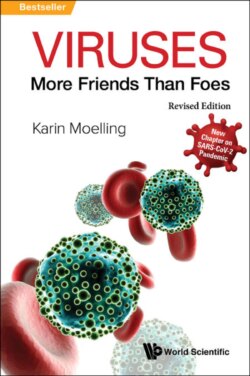Читать книгу Viruses: More Friends Than Foes (Revised Edition) - Karin Moelling - Страница 41
На сайте Литреса книга снята с продажи.
Driving HIV into “suicide”
ОглавлениеTogether with my colleagues we designed an approach in Zurich, to kill HIV before it infects a cell. Application in the vagina as microbicide seemed the most urgent application to us. “Driving HIV into suicide” was the headline of a commentary in the journal Nature Biotechnology where we published our results (2007). The University of Zurich printed postcards with this slogan, which one could pick up in the streetcars during the jubilee of the University. However, this did not help us to put the approach into practice. It is just too difficult and too expensive. The suicide of the virus is based on “molecular scissors” called RNase H, causing cleavage of the RNA in RNA-DNA hybrids. This process normally takes place inside cells after the viral RNA has been copied to DNA and is then useless. The scissors are present inside the virus particle, ready to go to work after the virus has entered the cell. Its activation inside the particles destroys the RNA before it is copied, so that the virus cannot replicate — a “suicide” or a dead end for the viral life cycle. (The scissors RNase H is one of four retroviral enzymes, the only one not yet targeted by an inhibitory drug because there are too many similar enzymes inside the cell. We activate this enzyme: treat the virus before it enters a cell and offer a piece of DNA which leads to a hybrid and activates the viral scissors, which kills the virus. We described the effect correctly as “silencer DNA” — but got a furious response from a reviewer, who said that only “silencer RNA” was acceptable — we gave in.)
A co-worker of mine introduced the DNA hairpin into the vagina of mice, using a gel as carrier. Only five years later we noticed that the same substance was approved by the U.S. agencies as a “wellness factor” during sexual intercourse and a lubricant for medical instruments in the trachea etc. The Bill and Melinda Gates foundation accepted our compound for testing in a standardized procedure — to make data directly comparable. Their procedure was, however, designed against HIV inside cells. This did not apply to our compound and therefore it failed, what I foresaw but could not prevent. The hairpin destroyed HIV in a special immune-deficient SCID mouse model successfully, it completely prevented infection and it also reduced significantly the size of tumors in mice. A tumor virus mouse model is a surrogate for HIV, which does not infect mice — which is a big problem for research, so for years only precious monkeys were used. New mouse models are being developed by “knocking-in” new properties. We submitted our results on tumor reduction and prevention as a manuscript to Nature Biotechnology. The reviewers requested a higher number of mice for better statistics within four weeks. This presented me with problems: the first author became pregnant and did not want to work in the animal house, another had left, other team members refused point-blank to take part in animal studies, and the only technician willing to help had no license. Out of 50 co-workers nobody could help. So I cancelled all appointments in the institute and did it myself — to my own surprise I had not forgotten, during the many years at the desk, how to handle and inject mice.
Meanwhile, we tried to fulfil the request made by the Bill and Melinda Gates Foundation that HIV microbicides should be long-lasting. We tested the DNA hairpin-loop after long storage and also in the presence of semen — a critical parameter for a useful microbicide. At the Heinrich Pette Institute for Experimental Virology in Hamburg we placed a little container at the men’s room asking for anonymous “donation” of semen. That worked out perfectly — but when we submitted the manuscript we were asked immediately before they even processed it for the written consent of the donors, including their names and in addition the written approval by the Ethics Committee at the Hospital — this took weeks. Such requests are totally new. (Even the donor of a feces sample for feces transfer, described below, was required retrospectively to submit written consent.) Thus: No body fluid can be taken from anybody without written consent — no tears or a drop of urine — because genes in the fluid may indeed be sequenced and reveal a lot of personal information.
What next? A bottleneck is the high-quality production of the DNA hairpin, according to Good Manufacturing Practice (GMP). This is almost impossible to pay for. I went to Russia, twice to China, once to Africa. HIV is still a taboo subject, and the outrageously expensive GMP production is required (even if I find it in some cases unnecessary) — no short-cut is allowed in the Third World, and one can even risk going to jail. During my visit to China the head of the admission committee was sentenced to death and shot for insufficiently strict obedience to the Chinese rules, which Western companies often try to circumvent by going to China. His organs may have saved some lives.
